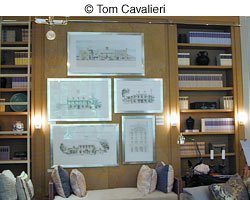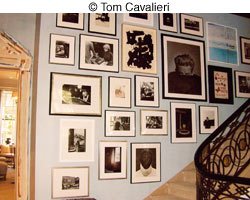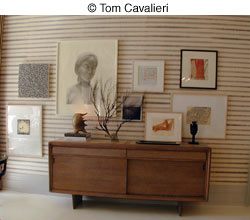Designers have learned from day one how to provide a focus to any room. One of the easiest ways is to provide a wall of great artwork. Recently, we at NYIAD had a chance to visit the 2006 Kips Bay Decorator Show House, a month long charity event where leading interior designers each decorate a different room in a Manhattan mansion. The rooms from this year's Kips Bay Decorator Show House clearly highlight the many different ways designers can display art work to their full glory.

To turn any wall into an instant focal point, try grouping art that has a similar theme together, as in this room designed by Katherine Newman. If displayed individually, these light renderings of architectural buildings might languish into the woodwork because of their fine line work, but framed in similar bold frames and grouped together they make a very strong architectural statement. One can visualize a library or a den by this wall alone.

What do you do with a bunch of odds and ends photos and artwork with no themes in common? Try placing them in that boring stretch of wall by your stairs. By using similar frames and the same color matting, you can tie together a disparate group of photos and artwork. Also do not skimp on the number of images, especially when they are only medium-sized, such as 11"x14" or smaller. A small selection on a large wall will look anemic. This grouping by the stairs makes a grand statement because it stretches from the ceiling to the top of the treads of the stairs.

When you have small framed artwork and you don't have enough to make a big statement, try creating a mural background for it, reflecting its theme as in this Little Gallery room designed by Joel Allen. These series of black and white animal prints are nice but lacking emphasis. Painting a mural of an exotic locale such as India where these animals may be found and hanging the prints all around it is a striking way to give impact to the room.

If you still don't have enough artwork to make a strong impact, but have only 4-6 medium to small paintings, try interspersing them with other accessories. This sitting room designed by Mario Buatta displays whimsical artwork of animals interspersed with brackets holding ceramic vases. The formal heavy antique frames are complemented by the baroque brackets – they are similar in formality and tone.
Another way to display your artwork is to pick up its theme with added sculpture. In this living room (below left) designed by Thom Felicia, the nature theme from the Starn Twins photograph of a curled leaf is picked up by the small round artwork of a bird which is in turn emphasized by the tall sculptural lines of the whale jaw bone positioned near by.


For a more informal look, you can group different sized artwork and lay them out in an almost hodgepodge manner as shown in this sideboard wall (above right) also by Thom Felicia. The mix of different textures, the grainy rice paper wall from Larsen, the black rough texture art work on the left against the smooth photograph and art prints create a cohesive statement of nature and art.
NYIAD Tip
One of the frequently asked questions is how high should I hang the artwork? The answer depends on the artwork and the type of room. If it's a gallery or hallway where the viewers are mostly standing, then art work should be hung higher up – around eye level standing up. Traditionally this means the center of the art work is 60 inches from the floor.

This could be higher if the ceilings are especially high or if art work is stacked one above the other or if you're viewing a really large picture. If the art work is going to be a living room or sitting room where the viewer is likely to be sitting down, then art work should be hung lower, as in the case of the artwork here in this living room designed by Rick Shaver.
Whichever layout you use, designers always try to tell a story with the art work. The art should complement the theme of the room or should provide a revealing window to the owner's lifestyle.







